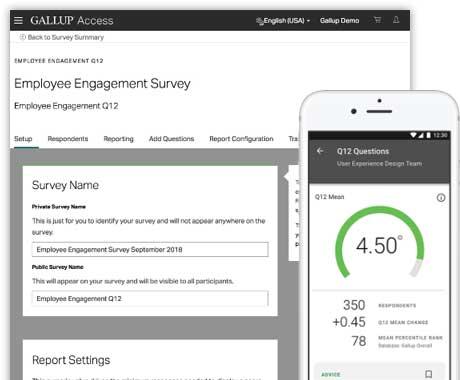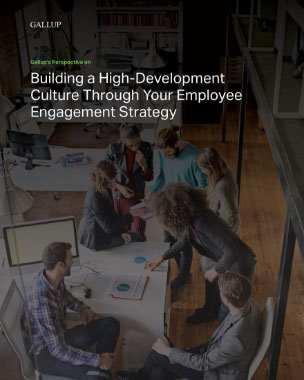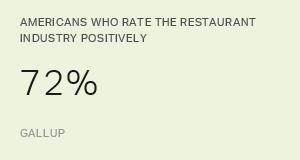Story Highlights
- Quality is no longer enough to create strong customer loyalty
- GMs shape the customer experience but lack support in navigating disruption
- Engaged GMs become brand ambassadors who lead more successful teams
The food service industry, like many others, is facing unprecedented disruption. From crushing competition to third-party delivery services (3PD), restaurants face some extraordinary challenges.
Leaders should view these as extraordinary opportunities. To take advantage of them, as a recent Gallup/TDn2K study of over 1,000 restaurant general managers shows, you need to carefully consider these innovations from the general manager's point of view.
This may seem a little counterintuitive. Yes, the customer's opinion is the one that matters most to your business. But GMs have extraordinary control over what customers experience.
The Challenges of Third-Party Delivery
As 3PD is more widely adopted, GMs will need guidance and clarity on how to control the brand experience from afar. Gallup recently researched 3PDs and identified some real challenges for GMs.
For instance, most GMs may not know why customers choose one 3PD over another, or why customers choose them at all. That lack of knowledge makes it difficult to position the brand locally in communities where customers are most inclined to use 3PDs.
Moreover, customers don't search 3PD apps for restaurants, they scroll for photos that look good. So the key to controlling your brand promise -- and remaining the top choice -- is curbing customers' scrolling habits by creating desirability for your brand before customers open the app. This means general managers have to understand how the dine-in experience can impact the entire omnichannel experience.
Your GMs are trying to navigate a disrupted industry, which affects what's expected of them, and they may not even know what those expectations are.
But only 41% of GMs strongly agree that they continually work with their district managers to clarify work priorities. If capturing the 3PD market is a priority for you, odds are your GMs don't know how to optimize your brand for 3PD customers.
Focusing on the Metrics That Matter
Customers care most about quality, naturally, but that's no differentiator. Industry-wide flat sales indicate that brands are not creating strong customer loyalty on quality alone. That's why so many brands use heavy promotions to pull customers in their doors. Sometimes those promotions lead to loyalty that lasts, but sometimes they're just a one-off bribe.
The key to long-term customer retention is aligning customers' unique expectations with your unique brand purpose. Front-line staff executes on that purpose -- in point of fact, they embody it -- if they are taught how. You need to evaluate your customer survey questions and assess if they truly measure the brand behaviors you want your front-life staff to convey.
If your local GMs have little control over the metrics you use -- and chances are, they don't -- you're measuring ineffective numbers and creating ineffective GMs.
Optimizing the Service-Profit Chain
Your GMs select, train, and develop employees and have the most impact on retention. At every point of the employee life cycle, your GMs are reinforcing -- or failing to reinforce -- the organizational culture. And 73% of restaurant GMs do not strongly agree that their coworkers are committed to doing quality work.
Meanwhile, only 35% of GMs can strongly agree that the mission or purpose of their company makes them feel their job is important. That's the single largest driver of engagement for general managers -- which may be why so many, 64%, are not engaged. And only 28% of hospitality industry employees strongly agree that "I know what my company stands for and what makes our brand(s) different from our competitors."
So even if GMs use quality metrics, they're trying to hit numbers through employees they don't trust in companies that don't inspire them.
No wonder the industry has 75% turnover -- most GMs have little respect for the other people you employ, they don't feel their company's purpose makes their jobs important, and they're largely disengaged.
Consequently, those GMs will almost certainly struggle to motivate, coach or engage their direct reports. So even if GMs use quality metrics, they're trying to hit numbers through employees they don't trust in companies that don't inspire them.
An Engagement Strategy for Restaurant Leaders
This may sound like a catalog of disasters. It's not. It's a list of priorities that will improve business if leaders address it.
Start anywhere -- these issues are all equally important. But leaders may find they get the most long-term traction by doubling down on GM engagement. Engaged workers are more loyal and more motivated, and those qualities will help you succeed with the other items on the list.
Gallup's workplace research has determined a scientifically validated method to improve engagement, and leaders should use it. Put the issues most associated with GM disengagement at the top of the list, things like the aforementioned lack of purpose or development issues -- the Gallup study found that only a third of GMs strongly agree that they've had conversations with their bosses about their goals in the past six months.
Engaged GMs are better at engaging their teams, too. Engaged workers are more loyal, profitable, productive, safer, less likely to steal and more likely to be effective brand ambassadors. Engaging GMs can have a substantial economic ripple effect throughout the operation, but they need to be engaged first.
Helping GMs master industry innovations like 3PD requires a top-down approach. Find out what customers believe about you, work with vendors and suppliers to differentiate yourself at a distance, and then strategize methods to create the same great experience of your brand wherever your customer goes. Then, tell your GMs what you learned and invite them to share what they think.
They're close to the front line and their opinions and insights are invaluable. Together, you can find a 3PD strategy that makes customers look for you first and always.
Don't let purpose slide off the list. If the concept of purpose seems too abstract, Gallup can help you actualize it. If the concept seems too obvious, you may be mistaking purpose for a slogan.
Seize the Opportunity Amid the Chaos
A company's purpose doesn't change, but the environment surrounding it does. Your GMs are trying to navigate a disrupted industry, which affects what's expected of them, and they may not even know what those expectations are. Most employees don't. Your expectations must be consistently communicated, and GMs need to be coached to achieve them. That focus can't end when the training program does.
When the brand's unique promise, the employees' authentic behavior, and the customers' emotional expectations are aligned, customers give that brand twice as much share of wallet.
Just don't let those gruesome numbers -- 64% not engaged, 73% distrusting their coworkers' commitment to quality, and just 25% strongly agree they are satisfied with their company as a place to work -- shake your faith in your GMs. Those numbers are extreme ... but extreme numbers are good news. They show that most of your competitors aren't doing what needs to be done to improve business.
Those who do act will have a real first-mover advantage. Spotting opportunity in chaos is how leaders succeed -- and there's a wealth of opportunity in the GM experience. Seize it.
Use engagement as your restaurant's competitive edge:
- Use Restaurant Manager Connect, a tool from TDn2K and Gallup, to measure your managers' engagement and compare it against competitive benchmarks.
- Download Gallup's new perspective paper consolidating decades of research and advice on improving business outcomes through employee engagement.
- Read our restaurant guide for increasing profitability, decreasing turnover and gaining loyal guests.






